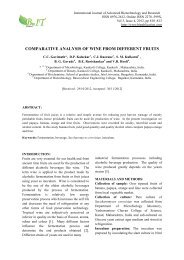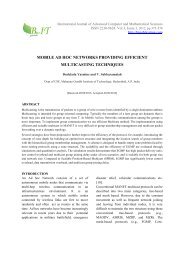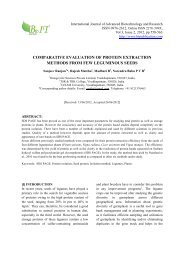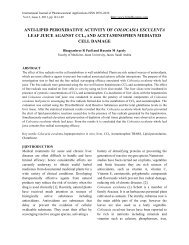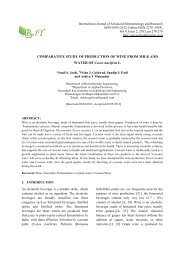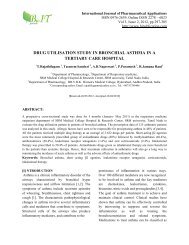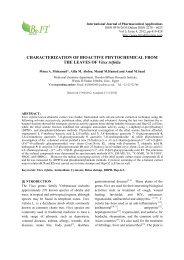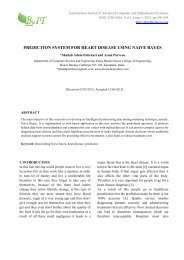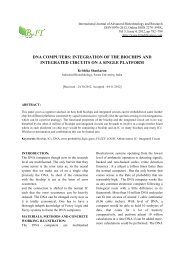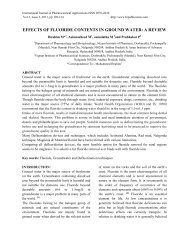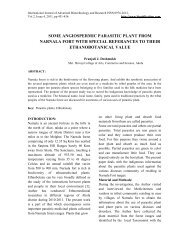influence of nitrogen sources and agitation in xanthan gum - BioIT ...
influence of nitrogen sources and agitation in xanthan gum - BioIT ...
influence of nitrogen sources and agitation in xanthan gum - BioIT ...
You also want an ePaper? Increase the reach of your titles
YUMPU automatically turns print PDFs into web optimized ePapers that Google loves.
INFLUENCE OF NITROGEN SOURCES AND AGITATION IN XANTHAN GUMon a variety <strong>of</strong> nutrients, particularly the <strong>nitrogen</strong><strong>and</strong> carbon <strong>sources</strong>, with glucose <strong>and</strong> sucrose asthe most frequently used carbon <strong>sources</strong> [6,7].Most commercial production method for <strong>xanthan</strong><strong>gum</strong> uses glucose or <strong>in</strong>vert sugars, <strong>and</strong> most<strong>in</strong>dustries prefer batch processes than cont<strong>in</strong>uousprocesses [8]. Other substrates have also beentested, such as sucrose, hydrolyzed rice, barley,corn flour, acid whey, sugar cane molasses,coconut juice, sugar cane, etc., but glucose is stillthe best <strong>in</strong> terms <strong>of</strong> product yield, supply, <strong>and</strong>product quality [5, 9-11]. It has been found thatthe production <strong>and</strong> the properties <strong>of</strong> <strong>xanthan</strong> <strong>gum</strong>are <strong><strong>in</strong>fluence</strong>d by bacterial stra<strong>in</strong> [12-13], culturemedium [8, 14-15], temperature [16-17], pH [18],time <strong>of</strong> fermentation [19], <strong>and</strong> <strong>agitation</strong> rate [20-21].The purpose <strong>of</strong> this study was to optimize the<strong>xanthan</strong> <strong>gum</strong> production by Xanthomonascampestris with respect to <strong>nitrogen</strong> <strong>sources</strong> <strong>and</strong>effect <strong>of</strong> <strong>agitation</strong>.[II] MATERIALS AND METHODS2.1. Microorganism <strong>and</strong> <strong>in</strong>oculum preparationXanthomonas campestris NCIM 2961 wasobta<strong>in</strong>ed from NCIM, Pune, <strong>and</strong> used throughoutthis study. The stra<strong>in</strong> was ma<strong>in</strong>ta<strong>in</strong>ed on nutrientagar slant conta<strong>in</strong><strong>in</strong>g (g/L) glucose 10; Maltextract 3; Yeast extract 3; <strong>and</strong> Peptone 5; pH=7grown at 30 °C for 24 hours <strong>and</strong> stored at 4 °C.Actively grow<strong>in</strong>g cells from a newly preparedslant were <strong>in</strong>oculated <strong>in</strong>to the liquid medium <strong>in</strong>250 ml Erlenmeyer flask. The culture was<strong>in</strong>cubated at 30-35 °C for 24 hours <strong>in</strong> an<strong>in</strong>cubator shaker. The liquid culture was used to<strong>in</strong>oculate the f<strong>in</strong>al fermentation medium.2.2. Fermentation experimentsAll the fermentation experiments were conducted<strong>in</strong> a 2L bioreactor (Biostat-B, Sartorius,Germany). The production medium wascomposed <strong>of</strong> glucose (25 g/L), yeast extract (3.0g/L), KH 2 PO 4 (2.0 g/L), MgSO 4 (1.0 g/L) <strong>and</strong>antifoam agent (0.1 mL/L). The fermentationmedium without the carbon source was sterilized<strong>in</strong> the fermentation vessel. The carbon source wassterilized separately <strong>and</strong> then aseptically<strong>in</strong>troduced <strong>in</strong>to the vessel. Dur<strong>in</strong>g fermentationruns, the dissolved oxygen concentration wasma<strong>in</strong>ta<strong>in</strong>ed at 10-30 % <strong>of</strong> saturation value by<strong>in</strong>creas<strong>in</strong>g the stirrer speed as needed, whilekeep<strong>in</strong>g constant 1 vvm (air volume/mediumvolume/m<strong>in</strong>ute) airflow rate. Temperature wasma<strong>in</strong>ta<strong>in</strong>ed constant at 28 °C for 24 h. The pH <strong>of</strong>the medium was held at pH=7.0 by add<strong>in</strong>g 1 MHCl/1M NaOH. Dur<strong>in</strong>g the process, theconcentrations <strong>of</strong> the cells, glucose, <strong>and</strong> <strong>xanthan</strong><strong>gum</strong> were measured <strong>in</strong> the culture medium <strong>in</strong> fivesamples <strong>of</strong> 50 mL each. All fermentation runswere conducted <strong>in</strong> triplicate.2.3. Determ<strong>in</strong>ation <strong>of</strong> biomass <strong>and</strong> <strong>xanthan</strong><strong>gum</strong> concentrationThe fermentation broth produced by the batchprocesses were diluted us<strong>in</strong>g distilled water tolower the viscosity, <strong>and</strong> then 20 mL aliquots weretransferred <strong>in</strong>to micro centrifuge tubes. Themicro-centrifuge tubes conta<strong>in</strong><strong>in</strong>g aliquots werecentrifuged at 10,000 rpm for 30 m<strong>in</strong>utes at 4 °C.After centrifugation, two fractions were formed,supernatant conta<strong>in</strong><strong>in</strong>g <strong>xanthan</strong> <strong>gum</strong>, <strong>and</strong> biomassdeposited as a pellet. The biomass pellet wasresuspended with water for wash<strong>in</strong>g <strong>and</strong> thenrecentrifuged to reprecipitate the biomass. Thebiomass deposited at the bottom <strong>of</strong> tubes wasdried <strong>in</strong> the oven at 60 °C for two hours <strong>and</strong>weighed to get the dry mass to show the relativeperformance <strong>of</strong> the cotton fibre <strong>in</strong> reta<strong>in</strong><strong>in</strong>g thecells. Supernatants were mixed with 2/3 (v/v)isopropanol, re-centrifuged at 10,000 rpm for 45m<strong>in</strong>utes at 4 °C to completely precipitate <strong>xanthan</strong><strong>gum</strong> before remov<strong>in</strong>g the solvent <strong>and</strong> water fromthe top portion. The precipitated <strong>xanthan</strong> <strong>gum</strong>collected from all samples was dried overnight <strong>in</strong>the oven at 50 to60 °C <strong>in</strong> the pre weighed micro-centrifuge tube.Aarthy Palaniraj et al. 306



